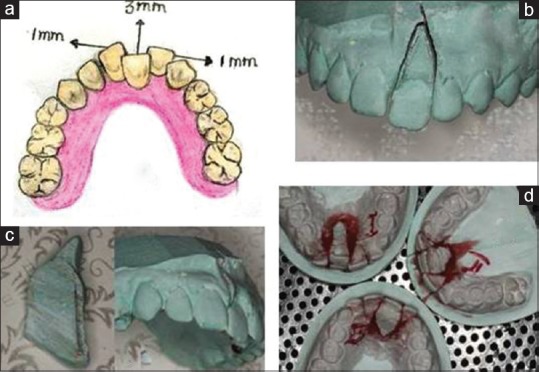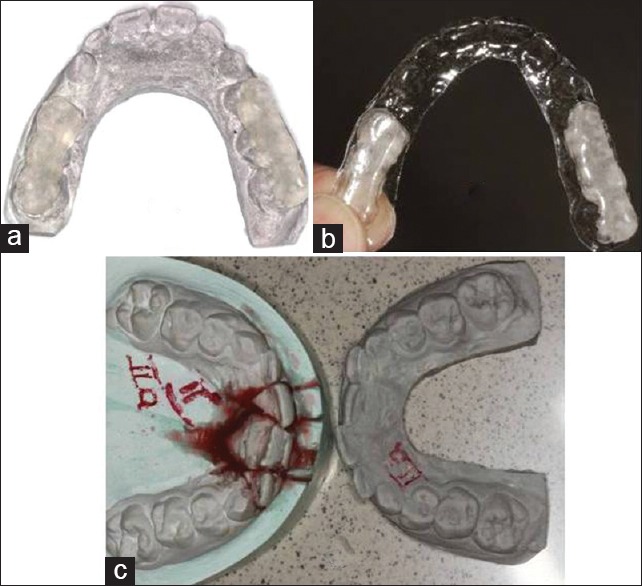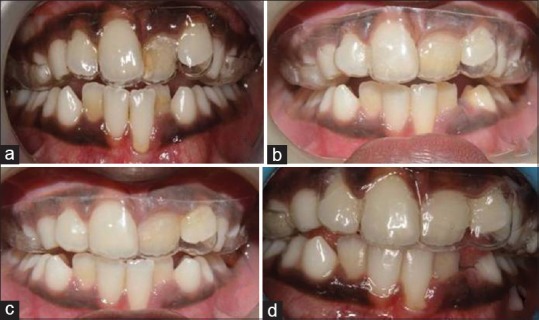Abstract
Anterior crossbite results from the abnormal axial inclination of one or more anterior teeth. It is a major esthetic and functional anomaly which has to be corrected in the primary and early mixed dentition period to allow the normal development of maxilla and mandible as well as the occlusion. Several treatment options are available to correct the problem. A unique appliance, “modified transparent tray aligners” was used to correct the anterior crossbite in an 8-year-old child. The clinical presentation, fabrication of the appliance, and the outcome are discussed.
Key words: Anterior crossbite, Invisalign®, transparent aligners
Introduction
Anterior crossbite is a major esthetic and functional anomaly which has to be corrected at the onset in primary as well as mixed dentition[1] to allow the normal development of occlusion. Moyer describes anterior crossbite as abnormal axial inclination of one or more maxillary teeth.[2] It is the lingual positioning of the maxillary anterior teeth in relation to the mandibular anterior teeth[3] or lingo-occlusion of upper incisors or reverse over jet.
Anterior dental crossbite has a reported worldwide incidence of 4–5%.[4] It also exhibits strong ethnic characterization as seen in 10% of Japanese population.[4] Etiological factors include trauma, supernumerary teeth, crowding, lip biting, over-retained, necrotic or pulpless primary tooth or root, delayed exfoliation of the primary incisors, and odontomas.[5,6]
Anterior crossbite could be dental, skeletal, or functional. Functional crossbite or pseudo class 3 results from an early dental interference that forces the mandible to a more forward position to obtain maximum intercuspation. An acquired muscular reflex pattern is involved in functional crossbite.
Anterior and posterior crossbites in the early mixed dentition are believed to be transferred from the primary to the permanent dentition and can have long-term effects on the growth and development of the teeth and jaws. Early treatment[7] is directed with the following objectives:
To prevent dysplastic growth of both dental and skeletal components
To prevent excessive, abnormal wear of labial surface of maxillary and mandibular incisors
To avoid periodontal problems in mandibular incisors because of trauma
To alleviate functional posterior crossbite that can develop from cuspal interferences and mandibular shift that happens to accommodate the crossbite
To prevent habits such as bruxism resulting from improper occlusion,[8] and
Early treatment can re-establish proper muscle balance, thus prevents jaw muscles adjusting to the habitual posture of the mandible.[9]
Several orthodontic and nonorthodontic treatment options are available. Nonorthodontic options include tongue blades, composite inclined planes, reversed stainless steel crowns, abnormally bulky restorations, and extractions followed by prosthetic replacement in older populations. Other less common options include selective recontouring of teeth, surgically repositioning teeth, and segmental osteotomy of the affected teeth.[10]
Orthodontic options include various removable acrylic appliances and fixed appliances with lingual springs and expansion screws. All options have their merits and demerits.
The name Invisalign® (Align Technology, Inc., San Jose, CA, USA) has given rise to various other similar techniques such as clear align and clear bite. Invisalign® itself was influenced by decades old concept in orthodontics.
Kesling in 1946 described the concept of using a series of thermoplastic positioners to move teeth. Align technology in 1997 introduced clear aligner technology. Over the years, it has evolved and can correct many irregularities which were not possible with earlier appliances. Basically, all these appliances use a series of clear aligners and move teeth in a series of 0.25–1 mm at a time and are worn from 7 to 14 days per tray according to different manufactures. Initially, it was fabricated on stone casts which has given way to thermoforming and three-dimensional printing. This has given the manufactures a better control over tooth movements.[11]
The major drawbacks of clear aligners are the phenomenal costs and some limitations in tooth movement. When applying this science to anterior crossbite correction, it had the following limitations.
Bite needs to be opened to correct crossbite. The tray being thin (0.5 mm sheet) cannot open the bite when done in maxillary arch alone. If both arches are done in some cases, it can be managed
Use of thicker sheets is not possible to overcome this, as thicker sheets will not have elasticity and will impart larger forces.
The solution is to sufficiently fabricate thin posterior bite plane in cold cure acrylic, finish it, and place it on the master cast and clear tray is fabricated over it.
This case report documents a case of an anterior crossbite which was successfully corrected using modified clear tray aligners, which can be fabricated in our clinical setting.
Case Report
An 8-year-old girl reported to the Department of Pedodontics and Preventive Dentistry, with a complaint of irregular tooth in the upper arch. Family history and health history were not significant and no known allergies were reported. On examination, the maxillary left central was in crossbite in relation to the lower incisors. There was a space deficiency of 2 mm mesiodistally for the tooth to get corrected. The option of arch expansion and “Z” spring was also considered. It was decided to use modified tray aligners in this case.
Consent was obtained; the cost and procedure were explained to the parent. Rubber base impression was taken, and four models were prepared. One was used as a study cast and the other three were marked as I, II, and III. A plan [Figure 1a] for tooth movement was made. A “V” cut [Figure 1b] was made to separate the tooth to be moved from the base, one at a time [Figure 1c]. Initially, the maxillary right central incisor was moved 0.5 mm distally and fixed with wax. Then, the maxillary left central incisor was cut and moved 0.5 mm anteriorly and fixed with wax. Later, the maxillary left lateral incisor was moved 0.5 mm distally and fixed with wax. This will open up space for maxillary left central incisor to move anteriorly. Model number two and three were cut and the tooth was moved to 1 mm and 1.5 mm so that each model will move the tooth 0.5 mm in a succession. All the models were finished using modeling wax to fill all the spaces created with cutting and moving the tooth. These will serve as master casts [Figure 1d].
Figure 1.

Plan for tooth movement (a), ‘V’ cut for separation (b), separated tooth (c), and teeth repositioned with wax (d)
From these master casts, new impressions were made and models were prepared to serve as working casts. Posterior bite plane was constructed sufficiently to open the bite [Figure 2a]. The acrylic was extended occlusally and about 1-1.5 mm buccolingually so that it will form an undercut and will lock into the tray material. This is placed on the cast and clear tray material of 0.5 mm was fabricated using thermoforming machine with vacuum. The bite plane gets nicely locked into the tray and will not be accidently dislodged when in use [Figure 2b]. The excess material were cut and finished and kept in marked packets to be given to the patient. All the models should be preserved till the end of the treatment so as to make any corrections during the treatment.
Figure 2.

Posterior bite plane constructed (a), bite plane within the aligner (b), and models with tooth reposition (c)
If a tray cannot be inserted with moderate pressure, it means that the tooth has been moved in excess. In that case, another model can be created by pushing back the tooth slightly in the master cast, a working cast is prepared and another tray is created. Thus, even if the tooth is moved in excess and the tray is not fitting, it is possible to correct it at any stage.
Instructions to the patient
The appliance has to be in position as much time as possible, except during meal time or consuming warm or hot liquids. The trays should be brushed gently along with the tooth brushing, twice a day. Initially, the tray will be slightly tight on insertion, and light pressure should be used to seat it fully onto the teeth.
The pain experienced during the initial few hours to a day or two will be due to the tooth movement. If the pain persists, if the tray cannot be seated or the edges of the tray bruise the soft tissues, report to your dentist at the earliest and get the trays adjusted. The tray should be used for 7 days and progress to new set in the series. Follow-up visits are scheduled every week as new tray will be inserted.
Discussion
After the first tray was used, the child experienced difficulty in inserting the second tray. To correct this problem, a model between 1 and 2 was needed. Hence, the original model no. 2 was modified. This was done by softening the wax in between the teeth with a warm wax knife and moving the incisor 0.25 mm behind so that it is positioned in between numbers 1 and 2. Then, the cast was finished, an impression was made of the corrected master cast, and a new working model was prepared. This was labeled 1a and the original number 2 model will become number 2b [Figure 2c]. Four clear trays were used to correct the crossbite successfully over a period of 4 weeks’ time Figure 3a–d, with the pre- and post-treatment pictures show an esthetically acceptable result [Figure 4a and b].
Figure 3.

Different aligners used for correction of the crossbite (a-d)
Figure 4.

Preoperative (a) and postoperative (b) view of the maxillary anterior teeth
A desire for cosmetic solution in search of comfortable and well-designed appliances than the bulkier ones has led to newer treatment modalities. Transparent aligners are useful in space maintenance, space regaining,[12] correction of crowding and spacing.[13,14,15] They can also be used for arch expansion or constriction, anterior and posterior crossbite correction,[15,16,17,18,19] and mild skeletal class 3 corrections.[20,21]
This technique of manual positioning can be easily performed for correction of three teeth. If more than three teeth require correction, it requires considerable expertise as it is easy to lose the track of the direction and distance, when the tooth is moved. If additional tooth movements such as extrusion or rotation are necessary, a small composite resin build-up (button) of 1 mm on the facial surface of the tooth should be made before the initial impression in the first appointment and will remain on the child's teeth till the end of the treatment.[22] This will be transferred to the model when the cast is made. The tray forms the button space when adapted over the cast. This facilitates the tray to lock on to this button and will not allow the tray to slip, and in turn enables better tooth movement. Otherwise, the tooth will not move appropriately to the desired position during extrusion or rotations.
Ideal forces vary from 35 to 60 g for tipping and 70-120 g for translation.[23] Hahn et al. recorded 282-542 g of force being applied for 1.51 mm of movement done.[23] In comparison, Invisalign uses 0.25 mm of movement per tray and uses new plastic called smart track, which is more resilient.[24] Drake et al. reported that though bodily protraction of the target tooth was programed during the fabrication of aligners, uncontrolled tipping resulted. Uncontrolled tipping and loss of anchorage have a bearing on the result of aligners.[25]
Duong and Kuo compared the load deflection rates of nickel-titanium (NiTi) and stainless steel wires of 0.017 × 0.017 with 0.030 mm polyurethane material in vitro and found that the load deflection of the polyurethane was greater than the NiTi wire but less than the stainless steel wire.[26] Krishnan and Davidovitch reported that the tooth targeted by clear aligner did not undergo the classic cycle of tooth movement as there is some amount of distortion of tray after wearing it for 1-2 days resulting in orthodontic forces tapering off.[27] Hence, even if slightly higher force is applied, it will not harm the tooth as the force will start diminishing after a day.
The tray aligners have an inherent disadvantage of tipping. Most of the time, we need only tipping force to correct the crossbite. Use of thin sheets of 0.5 mm will result in optimal force applied to the teeth. Care should be taken not to move the tooth more than 0.5 mm per tray as it will result in more force applied to the tooth as well as difficulty in insertion of the tray.
Conclusion
Esthetics and convenience has already emerged as the important factors in the acceptance of treatment as children have become very conscious of their appearance with the orthodontic appliances. Modified tray aligners can be easily fabricated in clinic setting, which makes it very affordable. These aligners are transparent, comfortable, and easily tolerated and have only minimal or no speech disturbance.
Financial support and sponsorship
Nil.
Conflicts of interest
There are no conflicts of interest.
References
- 1.Frey CJ, Full CA. Correction of combined anterior and posterior crossbites in the primary dentition with fixed appliances: Case report. Pediatr Dent. 1988;10:105–7. [PubMed] [Google Scholar]
- 2.Moyers RE. Hand Book of Orthodontics. 3rd ed. Chicago: Year Book Medical Publishers; 1983. pp. 574–7. [Google Scholar]
- 3.Spear FM. The esthetic correction of anterior dental mal-alignment conventional vs. instant (restorative) orthodontics. J Calif Dent Assoc. 2004;32:133–41. [PubMed] [Google Scholar]
- 4.Tsai HH. Components of anterior crossbite in the primary dentition. ASDC J Dent Child. 2001;68:27–32. [PubMed] [Google Scholar]
- 5.Olsen CB. Anterior crossbite correction in uncooperative or disabled children. Case reports. Aust Dent J. 1996;41:304–9. doi: 10.1111/j.1834-7819.1996.tb03138.x. [DOI] [PubMed] [Google Scholar]
- 6.Major PW, Glover K. Treatment of anterior cross-bites in the early mixed dentition. J Can Dent Assoc. 1992;58:574. [PubMed] [Google Scholar]
- 7.Vadiakas G, Viazis AD. Anterior crossbite correction in the early deciduous dentition. Am J Orthod Dentofacial Orthop. 1992;102:160–2. doi: 10.1016/0889-5406(92)70029-A. [DOI] [PubMed] [Google Scholar]
- 8.Myers DR, Barenie JT, Bell RA, Williamson EH. Condylar position in children with functional posterior crossbites: Before and after crossbite correction. Pediatr Dent. 1980;2:190–4. [PubMed] [Google Scholar]
- 9.McNamara JA., Jr Early intervention in the transverse dimension: Is it worth the effort? Am J Orthod Dentofacial Orthop. 2002;121:572–4. doi: 10.1067/mod.2002.124167. [DOI] [PubMed] [Google Scholar]
- 10.Post AC, Balaban B, Ackerson HA, Vaught RD. Correction of anterior cross-bite using segmental osteotomies and a fixed splint. J Prosthet Dent. 1980;43:516–20. doi: 10.1016/0022-3913(80)90323-6. [DOI] [PubMed] [Google Scholar]
- 11.Kuo E, Miller RJ. Automated custom-manufacturing technology in orthodontics. Am J Orthod Dentofacial Orthop. 2003;123:578–81. doi: 10.1067/mod.2003.S0889540603000519. [DOI] [PubMed] [Google Scholar]
- 12.Kim TW, Park JH. An aesthetic orthodontic treatment option: Fabrication and applications. Dent Today. 2008;27:132, 134–5. [PubMed] [Google Scholar]
- 13.Boyd RL, Miller RJ, Vlaskalic V. The invisalign system in adult orthodontics: Mild crowding and space closure cases. J Clin Orthod. 2000;34:203–12. [Google Scholar]
- 14.Boyd RL, Vlaskalic V. Three-dimensional diagnosis and orthodontic treatment of complex malocclusions with the invisalign appliance. Semin Orthod. 2001;7:274–93. [Google Scholar]
- 15.Vlaskalic V, Boyd R. Orthodontic treatment of a mildly crowded malocclusion using the invisalign system. Aust Orthod J. 2001;17:41–6. [PubMed] [Google Scholar]
- 16.Park JH, Kim TW. Anterior crossbite correction with a series of clear removable appliances: A case report. J Esthet Restor Dent. 2009;21:149–59. doi: 10.1111/j.1708-8240.2009.00257.x. [DOI] [PubMed] [Google Scholar]
- 17.Biradar A, Prakash GS, Manohar MR. Early correction of developing anterior crossbite with modified Essex appliance. J Indian Orthod Soc. 2012;46:159–61. [Google Scholar]
- 18.Kim TW, Gaugel H. Cross-bite-correction with eCligner. [Last accessed on 2016 May 13];J Compr Dentofaciol Orthod Orthop. 2015 3-4:86–90. Available from http://www.andersson-gaugel.de/pdf/kfo-intern-11-2015.pdf . [Google Scholar]
- 19.Shah N, Rao A, Suprabha BS, Rao A. Correction of a single tooth anterior dental crossbite using a fixed Z-spring: A series of three cases. Int J Adv Res. 2014;2:608–11. [Google Scholar]
- 20.Needham R, Waring DT, Malik OH. Invisalign treatment of Class III malocclusion with lower-incisor extraction. J Clin Orthod. 2015;49:429–41. [PubMed] [Google Scholar]
- 21.Yezdani AA. Transparent aligners: An invisible approach to correct mild skeletal class III malocclusion. J Pharm Bioallied Sci. 2015;7(Suppl 1):S301–6. doi: 10.4103/0975-7406.155965. [DOI] [PMC free article] [PubMed] [Google Scholar]
- 22.Hahn W, Engelke B, Jung K, Dathe H, Fialka-Fricke J, Kubein-Meesenburg D, et al. Initial forces and moments delivered by removable thermoplastic appliances during rotation of an upper central incisor. Angle Orthod. 2010;80:239–46. doi: 10.2319/033009-181.1. [DOI] [PMC free article] [PubMed] [Google Scholar]
- 23.Hahn W, Dathe H, Fialka-Fricke J, Fricke-Zech S, Zapf A, Kubein-Meesenburg D, et al. Influence of thermoplastic appliance thickness on the magnitude of force delivered to a maxillary central incisor during tipping. Am J Orthod Dentofacial Orthop. 2009;136:12.e1–7. doi: 10.1016/j.ajodo.2008.12.015. [DOI] [PubMed] [Google Scholar]
- 24.Hahn W, Fialka-Fricke J, Dathe H, Fricke-Zech S, Zapf A, Gruber R, et al. Initial forces generated by three types of thermoplastic appliances on an upper central incisor during tipping. Eur J Orthod. 2009;31:625–31. doi: 10.1093/ejo/cjp047. [DOI] [PubMed] [Google Scholar]
- 25.Drake CT, McGorray SP, Dolce C, Nair M, Wheeler TT. Orthodontic tooth movement with clear aligners. ISRN Dent. 2012;2012:657973. doi: 10.5402/2012/657973. [DOI] [PMC free article] [PubMed] [Google Scholar]
- 26.Duong T, Kuo E. Finishing with invisalign. Prog Orthod. 2006;7:44–55. [PubMed] [Google Scholar]
- 27.Krishnan V, Davidovitch Z. Cellular, molecular, and tissue-level reactions to orthodontic force. Am J Orthod Dentofacial Orthop. 2006;129:469.e1–32. doi: 10.1016/j.ajodo.2005.10.007. [DOI] [PubMed] [Google Scholar]


